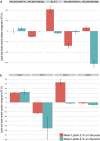Inference and interrogation of a coregulatory network in the context of lipid accumulation in Yarrowia lipolytica
- PMID: 28955503
- PMCID: PMC5554221
- DOI: 10.1038/s41540-017-0024-1
Inference and interrogation of a coregulatory network in the context of lipid accumulation in Yarrowia lipolytica
Abstract
Complex phenotypes, such as lipid accumulation, result from cooperativity between regulators and the integration of multiscale information. However, the elucidation of such regulatory programs by experimental approaches may be challenging, particularly in context-specific conditions. In particular, we know very little about the regulators of lipid accumulation in the oleaginous yeast of industrial interest Yarrowia lipolytica. This lack of knowledge limits the development of this yeast as an industrial platform, due to the time-consuming and costly laboratory efforts required to design strains with the desired phenotypes. In this study, we aimed to identify context-specific regulators and mechanisms, to guide explorations of the regulation of lipid accumulation in Y. lipolytica. Using gene regulatory network inference, and considering the expression of 6539 genes over 26 time points from GSE35447 for biolipid production and a list of 151 transcription factors, we reconstructed a gene regulatory network comprising 111 transcription factors, 4451 target genes and 17048 regulatory interactions (YL-GRN-1) supported by evidence of protein-protein interactions. This study, based on network interrogation and wet laboratory validation (a) highlights the relevance of our proposed measure, the transcription factors influence, for identifying phases corresponding to changes in physiological state without prior knowledge (b) suggests new potential regulators and drivers of lipid accumulation and
(c) experimentally validates the impact of six of the nine regulators identified on lipid accumulation, with variations in lipid content from +43.2% to -31.2% on glucose or glycerol.
Conflict of interest statement
The authors declare that they have no competing financial interests.
Figures



Similar articles
-
Overexpression screen reveals transcription factors involved in lipid accumulation in Yarrowia lipolytica.FEMS Yeast Res. 2018 Aug 1;18(5). doi: 10.1093/femsyr/foy037. FEMS Yeast Res. 2018. PMID: 29617806
-
High-throughput fermentation screening for the yeast Yarrowia lipolytica with real-time monitoring of biomass and lipid production.Microb Cell Fact. 2016 Aug 23;15(1):147. doi: 10.1186/s12934-016-0546-z. Microb Cell Fact. 2016. PMID: 27553851 Free PMC article.
-
Multi-omics analysis reveals regulators of the response to nitrogen limitation in Yarrowia lipolytica.BMC Genomics. 2016 Feb 25;17:138. doi: 10.1186/s12864-016-2471-2. BMC Genomics. 2016. PMID: 26911370 Free PMC article.
-
Yarrowia lipolytica: A model and a tool to understand the mechanisms implicated in lipid accumulation.Biochimie. 2009 Jun;91(6):692-6. doi: 10.1016/j.biochi.2009.02.004. Epub 2009 Feb 25. Biochimie. 2009. PMID: 19248816 Review.
-
Yarrowia lipolytica as a model for bio-oil production.Prog Lipid Res. 2009 Nov;48(6):375-87. doi: 10.1016/j.plipres.2009.08.005. Epub 2009 Aug 29. Prog Lipid Res. 2009. PMID: 19720081 Review.
Cited by
-
'Mother(Nature) knows best' - hijacking nature-designed transcriptional programs for enhancing stress resistance and protein production in Yarrowia lipolytica; presentation of YaliFunTome database.Microb Cell Fact. 2024 Jan 18;23(1):26. doi: 10.1186/s12934-023-02285-x. Microb Cell Fact. 2024. PMID: 38238843 Free PMC article.
-
Yarrowia lipolytica Strains and Their Biotechnological Applications: How Natural Biodiversity and Metabolic Engineering Could Contribute to Cell Factories Improvement.J Fungi (Basel). 2021 Jul 10;7(7):548. doi: 10.3390/jof7070548. J Fungi (Basel). 2021. PMID: 34356927 Free PMC article. Review.
-
Synthetic biology, systems biology, and metabolic engineering of Yarrowia lipolytica toward a sustainable biorefinery platform.J Ind Microbiol Biotechnol. 2020 Oct;47(9-10):845-862. doi: 10.1007/s10295-020-02290-8. Epub 2020 Jul 4. J Ind Microbiol Biotechnol. 2020. PMID: 32623653 Review.
-
Synthetic biology tools for engineering Yarrowia lipolytica.Biotechnol Adv. 2018 Dec;36(8):2150-2164. doi: 10.1016/j.biotechadv.2018.10.004. Epub 2018 Oct 11. Biotechnol Adv. 2018. PMID: 30315870 Free PMC article. Review.
-
Engineering Yarrowia lipolytica for Use in Biotechnological Applications: A Review of Major Achievements and Recent Innovations.Mol Biotechnol. 2018 Aug;60(8):621-635. doi: 10.1007/s12033-018-0093-4. Mol Biotechnol. 2018. PMID: 29943148 Review.
References
LinkOut - more resources
Full Text Sources
Other Literature Sources
Molecular Biology Databases
Miscellaneous

